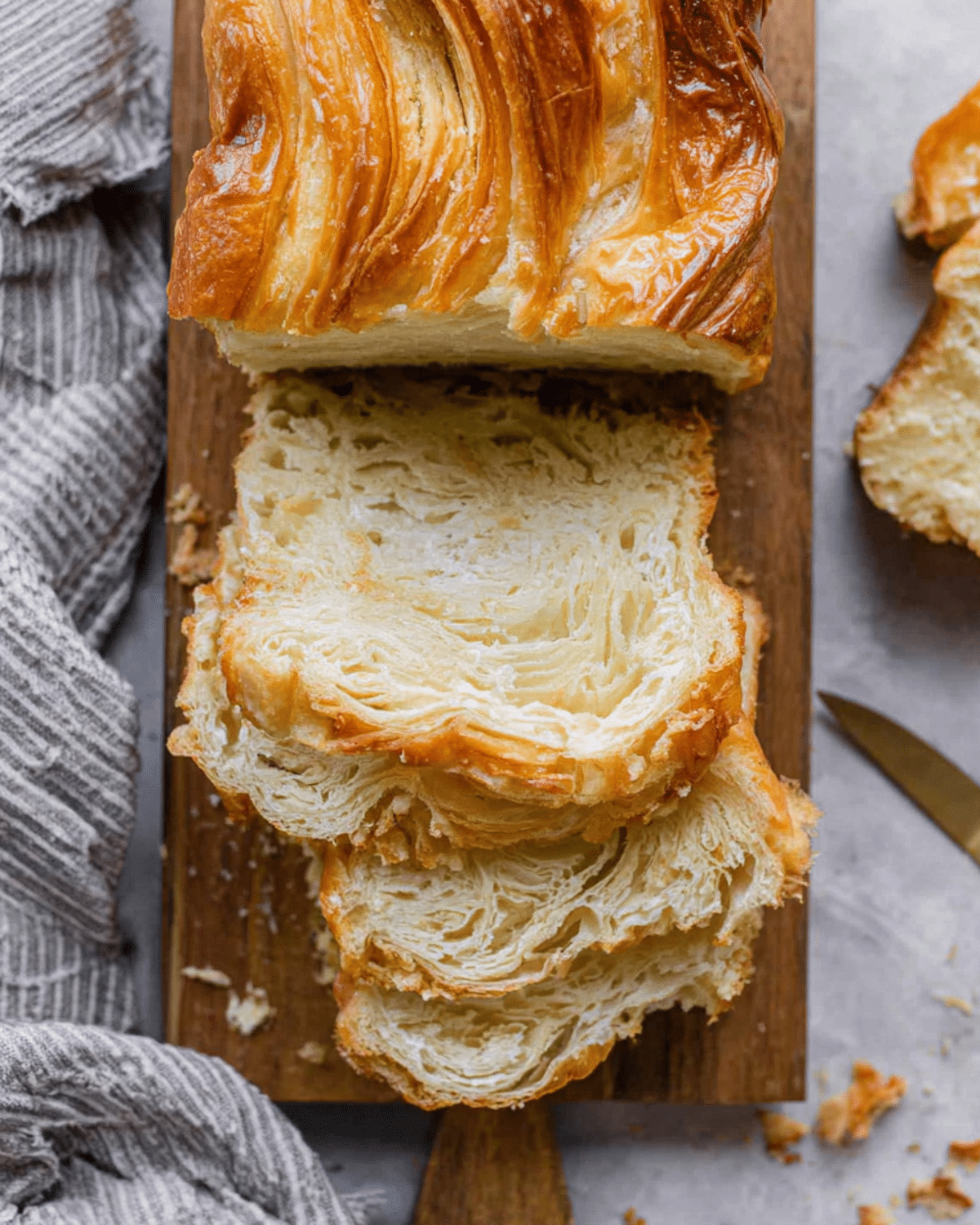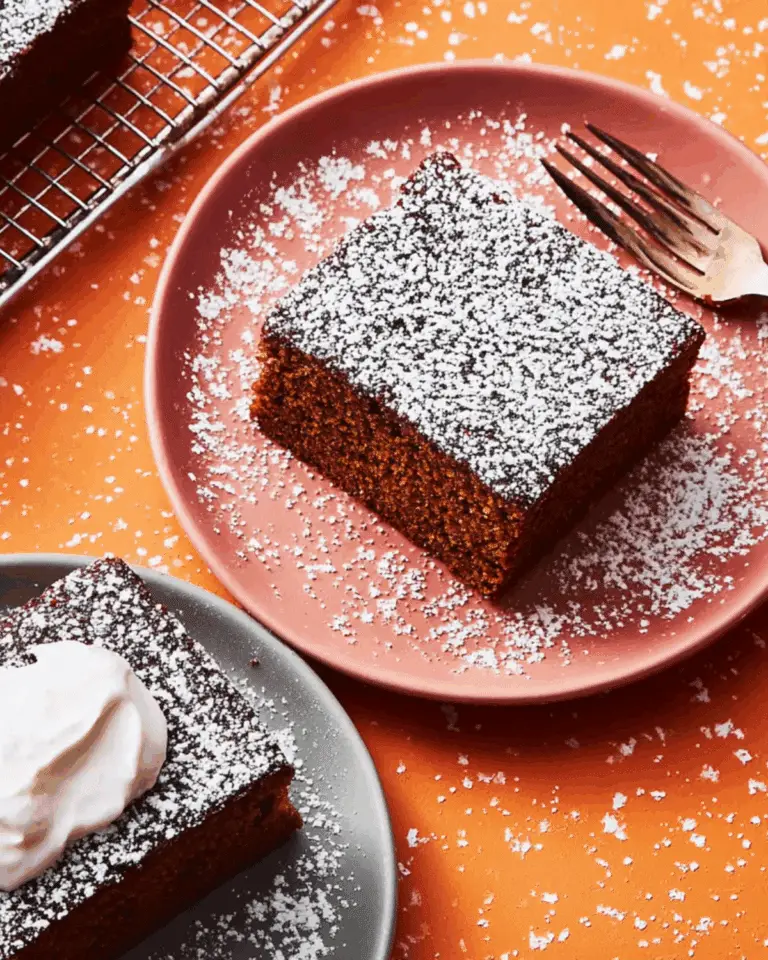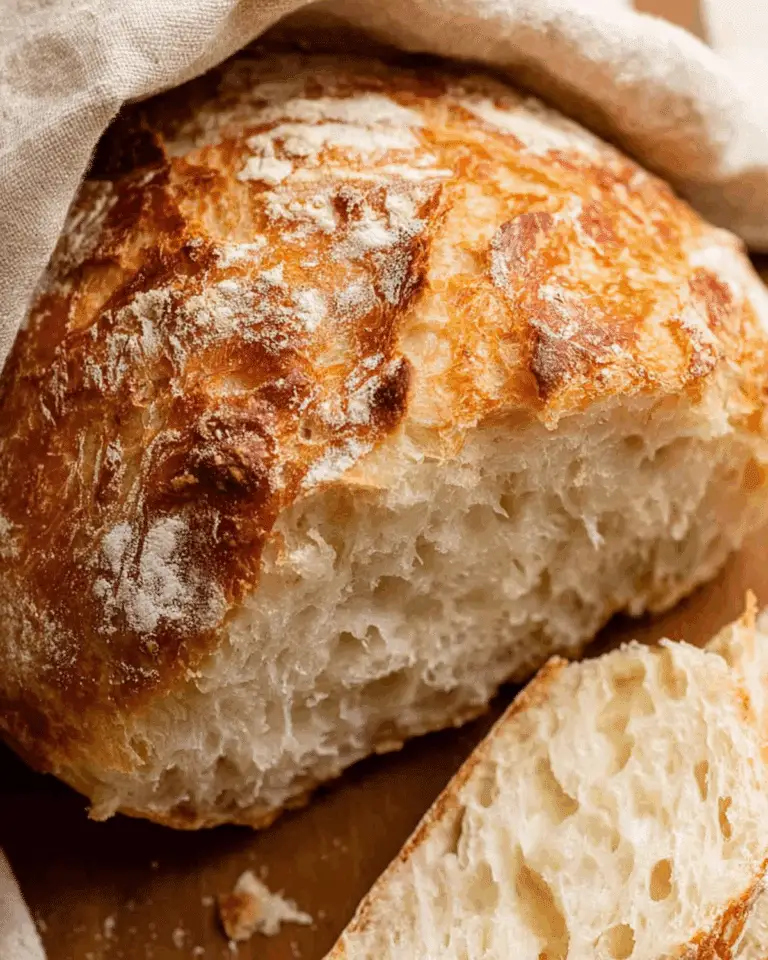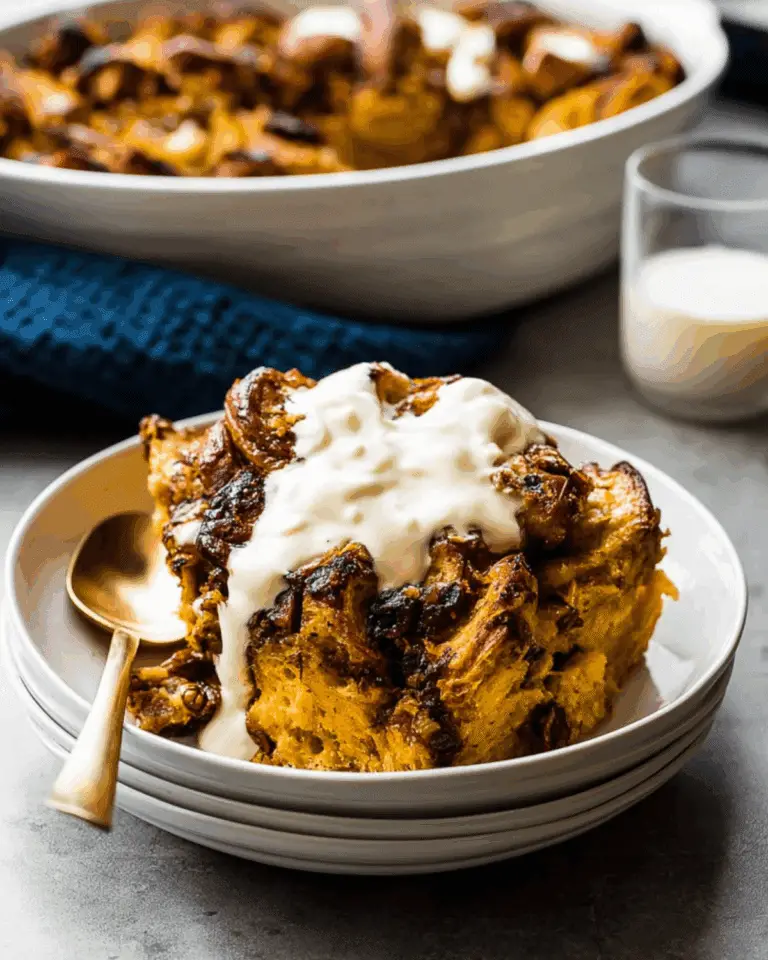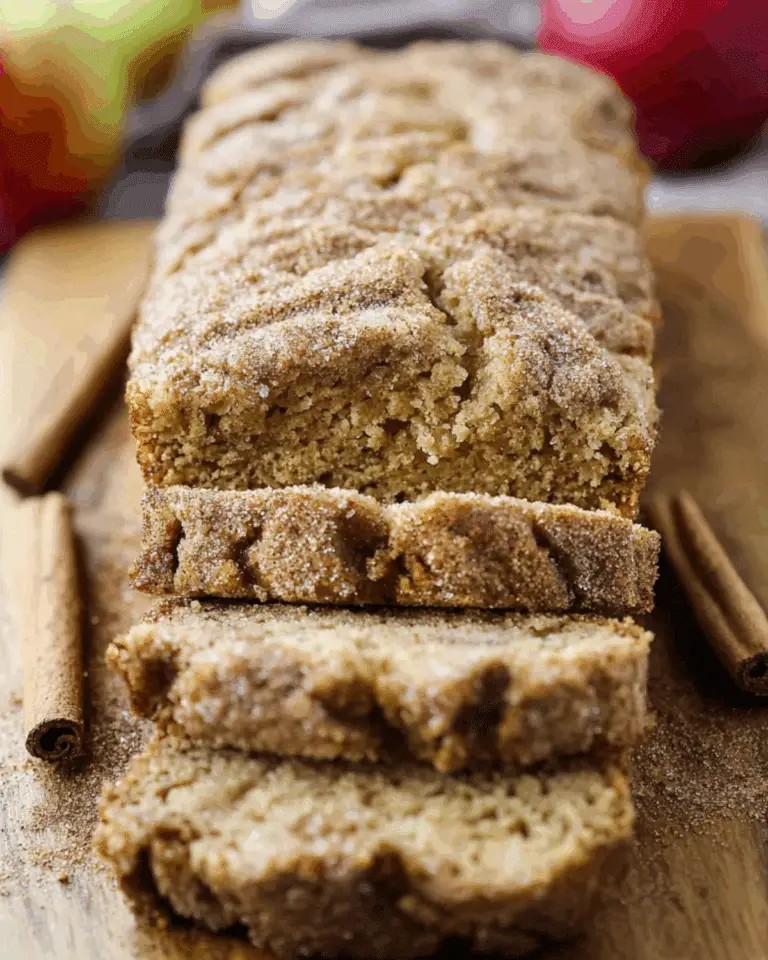A flaky, buttery croissant in the form of a loaf? Yes, please! This homemade croissant bread loaf gives you the rich, layered goodness of a French pastry with the sliceable convenience of sandwich bread. Whether you’re making French toast, grilled cheese, or just want something extra special for breakfast, this loaf brings a bakery-quality touch to your kitchen. Plus, it’s easier to make than you think.
Don’t miss our Focaccia Bread recipe if you’re craving more homemade bread options!
JUMP TO
Table of Contents
What is Croissant Bread Loaf and Why It’s So Irresistible
How Croissant Bread Differs From Classic Loaves
Unlike standard sandwich bread, croissant bread loaf is made with laminated dough. That means layers of cold butter are folded into the dough, creating dozens of delicate, flaky layers when baked. It looks rustic on the outside but slices cleanly like a soft loaf. It’s part croissant, part pull-apart bread—perfect for both sweet and savory meals.
The Secret Behind Its Light, Airy Texture
What sets this bread apart is the layering technique. During baking, steam from the butter causes the dough to puff between the folds, resulting in airy pockets and a tender crumb inside. Using milk instead of water adds richness, and honey brings a touch of natural sweetness without overwhelming the butter flavor.
Top Uses: Toast, Sandwiches, French Toast & More
Croissant bread loaf is incredibly versatile. Toast a slice and top it with cinnamon butter or jam. Want something savory? Use it for a next-level grilled cheese or a fancy BLT. Leftovers also make an amazing base for bread pudding or breakfast casseroles.
Looking for inspiration? Try this Croissant Breakfast Casserole that turns any morning into a feast.
Ingredients Needed for the Perfect Croissant Bread Loaf
Key Pantry Items You’ll Need
Here’s a look at what goes into a great croissant loaf:
| Ingredient | Purpose |
|---|---|
| Milk | Activates yeast and adds richness |
| Active Dry Yeast | Leavens the bread |
| Honey | Adds mild sweetness |
| Butter (softened & cold) | Creates rich layers through lamination |
| All-Purpose Flour | Best texture and structure |
| Salt | Enhances flavor |
| Egg & Milk | For a glossy, golden finish (egg wash) |
Every ingredient plays a role, but the butter is the star of the show. It must be just soft enough to slice but not too soft to melt into the dough.
Why Butter Temperature Matters in Laminating
Cold butter is essential to keep clean layers between folds. Too soft, and it melts into the dough, destroying the layering. Aim for butter that’s slightly pliable—sliceable but firm. If it softens too much while layering, pop the dough in the fridge for 20 minutes to firm it back up.
Ingredient Swaps and Flavor Additions
Want to get creative? Try these variations:
- Add chocolate chips or cinnamon sugar between folds
- Swap honey with maple syrup for a deeper flavor
- Sprinkle flaky salt or sesame seeds on top after the egg wash
Don’t miss our Brown Sugar Peach Cake for another buttery treat full of comfort and sweetness.
Step-by-Step Guide: How to Make Croissant Bread Loaf
Preparing the Enriched Dough Base
Start by combining warm milk, yeast, and honey in a stand mixer. Let it sit until foamy—this means your yeast is alive and ready. Mix in softened butter, flour, and salt. Knead until the dough is soft and elastic, then let it rise until doubled.
Once risen, roll it into a 9×14-inch rectangle and chill it. This cools the dough and gets it ready for lamination.
Check out No-Knead Bread for an even simpler starter dough recipe.
Laminating the Dough Like a Pro
Laminating means layering cold butter into the dough. Arrange butter slices over the center third, fold in the sides like a letter, then roll and chill. Repeat this process two more times, always rolling and chilling between steps. This is how the magic layers are built.
Rolling, Proofing & Baking to Golden Perfection
Once laminated, roll the dough into a tight log and place it in a loaf pan. Let it rise until it just tops the pan. Brush with egg wash, score the top, and bake at 375°F. Tent with foil halfway through to prevent over-browning. Bake until the crust is golden and the inside hits 190°F.
Discover great ideas like our French Toast Casserole for using croissant loaf the next day!
Pro Tips to Nail the Perfect Layers Every Time
Dough Chilling & Rolling Best Practices
Temperature control is everything when working with laminated dough. Always chill the dough between folds to keep the butter firm and layers distinct. When rolling, use firm but gentle pressure to avoid butter breaking through the surface. If the dough gets too warm or sticky, chill it again before continuing.
Here’s a quick tip: sprinkle a little flour on your rolling surface and pin, but don’t overdo it—too much flour can toughen the dough.
Egg Wash Tricks for That Glossy Crust
An egg wash is your best friend for that bakery-style finish. Use 1 egg mixed with a tablespoon or two of milk. Brush it gently over the loaf just before baking. For extra shine, brush twice—once before baking, then again halfway through. Avoid brushing too hard or it’ll deflate your risen dough.
Looking for inspiration? Try topping your loaf with everything bagel seasoning or sea salt flakes after the egg wash—game-changer!
Fixes for Common Issues (Sticky Dough, Overproofing)
Got sticky dough while kneading? Add flour one tablespoon at a time until it just pulls away from the bowl. Still sticky after chilling? Lightly flour the surface, but don’t panic. Stick it in the fridge for 10–15 more minutes.
Overproofed dough? It may collapse or bake up flat. To avoid this, only let it rise until it’s slightly above the loaf pan rim. Always check dough temperature, especially if your kitchen is warm.
Don’t miss our tips inside this Amish White Bread recipe to master even the simplest loaves before diving into laminated ones.
Creative Ways to Use Croissant Bread Loaf
French Toast Casserole with Croissant Bread
Croissant bread takes French toast to another level. Its buttery, flaky texture soaks up custard without going mushy. Cube it up, mix with eggs, cream, cinnamon, and vanilla, then bake until golden. It’s the perfect dish for holidays or Sunday brunch.
Check out our crowd-pleasing Biscuits and Gravy Breakfast Casserole if you’re in the mood for something hearty and Southern-style.
Croissant BLTs and Gourmet Sandwiches
Slice it thick and toast it lightly—this loaf is ideal for elevated sandwiches. A croissant BLT with crispy bacon, tomato, and aioli? Yes. Turkey and brie with fig jam? Absolutely. Because the bread is so rich, keep fillings simple and fresh.
Want more savory comfort? Don’t miss our cozy Creamy Lemon Salmon as the perfect pairing to a croissant loaf side.
Turn Leftovers into a Decadent Bread Pudding
Even stale croissant bread turns into gold. Just cut it into cubes, soak in a custard base (eggs, cream, vanilla, sugar), and bake. Toss in some chocolate chips or dried fruit. Serve warm with whipped cream or a scoop of vanilla ice cream.
You’ll love using up your loaf this way—and if you need another sweet idea, check out our Strawberry Freezer Jam to spread on fresh slices.
Storage and Make-Ahead Instructions
Freezing the Dough vs. Freezing Baked Loaf
You can freeze the croissant dough after laminating but before shaping. Wrap tightly and freeze for up to 2 weeks. Thaw in the fridge overnight before shaping and baking. Want to freeze the baked loaf? No problem—just let it cool fully, then wrap in foil and store in a zip bag for up to 2 months.
Slice it before freezing to make quick mornings even easier.
Keeping It Fresh for Up to a Week
At room temperature, this bread keeps fresh for about 2–3 days in an airtight container. For longer storage, refrigerate it—just be sure to warm slices before serving to bring back that flaky texture.
Wrap it in parchment then foil to prevent condensation and sogginess.
Reheating Without Losing Flakiness
Avoid microwaves—they zap the texture. Instead, reheat slices in a toaster or oven at 325°F for about 5–7 minutes. This revives the crisp layers and makes it taste like it just came out of the oven.
Discover great ideas like our Blueberry Butter to slather on warm slices for the ultimate breakfast moment.

FAQs About Croissant Bread Loaf
Is croissant bread the same as puff pastry?
Not quite. Puff pastry uses no yeast and relies entirely on butter and folds for its rise. Croissant bread, on the other hand, is a yeasted dough that gets laminated like puff pastry. The result? A loftier, bread-like interior with buttery, flaky layers.
Can I make croissant loaf without a stand mixer?
Yes, you can. It just takes a bit more elbow grease. Use your hands to knead the dough for about 10 minutes until it becomes soft and elastic. Be patient—it’s worth the effort, and many bakers find hand-kneading therapeutic!
Why didn’t my croissant bread rise properly?
Several culprits could be at play. Check your yeast—is it fresh? Was the milk too hot (which kills yeast) or too cold (which delays activation)? Also, avoid overproofing; this causes the dough to collapse. Aim for a warm, draft-free spot for rising and proof only until it doubles in size.
Final Thoughts: Why You’ll Love Making This Bread Again and Again
Whether you’re baking for brunch, making show-stopping sandwiches, or just love the buttery aroma of fresh bread, this croissant bread loaf delivers every time. With its flaky crust, tender center, and impressive look, it turns everyday meals into bakery-worthy bites. The step-by-step method makes it accessible—even for beginners.
Looking for your next bread challenge? Don’t miss our Easiest Rustic Bread for a no-fuss, crusty option.
PrintCroissant Bread Loaf
This Croissant Bread Loaf combines the rich, buttery layers of a croissant with the soft, sliceable texture of sandwich bread. Perfect for toast, French toast, or gourmet sandwiches.
- Prep Time: 20 minutes
- Cook Time: 40 minutes
- Total Time: 4 hours
- Yield: 1 loaf
- Category: Bread
- Method: Baking
- Cuisine: French-American
- Diet: Vegetarian
Ingredients
- 1 cup warm milk
- 1 packet (2 1/4 tsp) active dry yeast
- 3 tablespoons honey
- 3 tablespoons butter, softened
- 2–3 cups all-purpose flour
- 1 1/2 teaspoons salt
- 2/3 cup cold butter (for laminating)
- 1 egg (for egg wash)
- 2 tablespoons milk (for egg wash)
Instructions
- In a stand mixer bowl, whisk together warm milk, yeast, and honey. Let sit for 5 minutes until foamy.
- Add softened butter, 2 cups flour, and salt. Mix with dough hook. Add more flour as needed until dough pulls away from bowl.
- Knead dough for 5 minutes, then transfer to an oiled bowl and cover. Let rise at room temperature for 1 hour until doubled.
- Roll out risen dough into a 9×14-inch rectangle on a parchment-lined baking sheet. Cover and refrigerate for 20 minutes.
- Layer half the sliced cold butter over the center third of the dough. Fold one side over, then add the rest of the butter, and fold the other side over.
- Roll the dough into a 9×14-inch rectangle, fold like a letter, then refrigerate for 20 minutes. Repeat the rolling and folding 2 more times, chilling in between.
- Roll dough into a 9-inch log and place into a greased loaf pan. Cover and let rise until slightly above the pan rim.
- Preheat oven to 375°F. Score loaf, brush with egg wash, and bake uncovered for 10 minutes.
- Cover with foil and bake another 20 minutes until golden brown and internal temp reaches 190°F.
- Let cool in the pan for 10 minutes, then transfer to a wire rack to cool completely.
Notes
- Use cold, sliceable butter for proper lamination.
- Chill dough between folds to maintain clean layers.
- Egg wash twice for extra glossy crust.
- If dough becomes sticky, chill again before rolling.
- Use leftovers for French toast or bread pudding.
Nutrition
- Serving Size: 1 slice (1/8 of loaf)
- Calories: 340
- Sugar: 8g
- Sodium: 613mg
- Fat: 21g
- Saturated Fat: 13g
- Unsaturated Fat: 12g
- Trans Fat: 0.5g
- Carbohydrates: 32g
- Fiber: 1g
- Protein: 5g
- Cholesterol: 77mg

